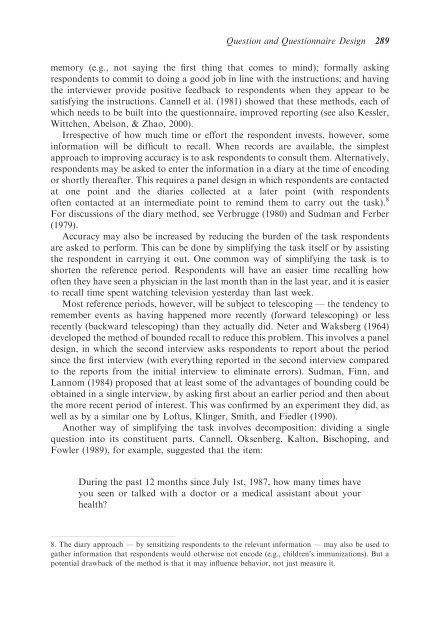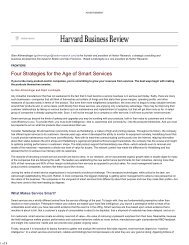Question and Questionnaire Design - Stanford University
Question and Questionnaire Design - Stanford University
Question and Questionnaire Design - Stanford University
Create successful ePaper yourself
Turn your PDF publications into a flip-book with our unique Google optimized e-Paper software.
<strong>Question</strong> <strong>and</strong> <strong>Question</strong>naire <strong>Design</strong> 289memory (e.g., not saying the first thing that comes to mind); formally askingrespondents to commit to doing a good job in line with the instructions; <strong>and</strong> havingthe interviewer provide positive feedback to respondents when they appear to besatisfying the instructions. Cannell et al. (1981) showed that these methods, each ofwhich needs to be built into the questionnaire, improved reporting (see also Kessler,Wittchen, Abelson, & Zhao, 2000).Irrespective of how much time or effort the respondent invests, however, someinformation will be difficult to recall. When records are available, the simplestapproach to improving accuracy is to ask respondents to consult them. Alternatively,respondents may be asked to enter the information in a diary at the time of encodingor shortly thereafter. This requires a panel design in which respondents are contactedat one point <strong>and</strong> the diaries collected at a later point (with respondentsoften contacted at an intermediate point to remind them to carry out the task). 8For discussions of the diary method, see Verbrugge (1980) <strong>and</strong> Sudman <strong>and</strong> Ferber(1979).Accuracy may also be increased by reducing the burden of the task respondentsare asked to perform. This can be done by simplifying the task itself or by assistingthe respondent in carrying it out. One common way of simplifying the task is toshorten the reference period. Respondents will have an easier time recalling howoften they have seen a physician in the last month than in the last year, <strong>and</strong> it is easierto recall time spent watching television yesterday than last week.Most reference periods, however, will be subject to telescoping — the tendency toremember events as having happened more recently (forward telescoping) or lessrecently (backward telescoping) than they actually did. Neter <strong>and</strong> Waksberg (1964)developed the method of bounded recall to reduce this problem. This involves a paneldesign, in which the second interview asks respondents to report about the periodsince the first interview (with everything reported in the second interview comparedto the reports from the initial interview to eliminate errors). Sudman, Finn, <strong>and</strong>Lannom (1984) proposed that at least some of the advantages of bounding could beobtained in a single interview, by asking first about an earlier period <strong>and</strong> then aboutthe more recent period of interest. This was confirmed by an experiment they did, aswell as by a similar one by Loftus, Klinger, Smith, <strong>and</strong> Fiedler (1990).Another way of simplifying the task involves decomposition: dividing a singlequestion into its constituent parts. Cannell, Oksenberg, Kalton, Bischoping, <strong>and</strong>Fowler (1989), for example, suggested that the item:During the past 12 months since July 1st, 1987, how many times haveyou seen or talked with a doctor or a medical assistant about yourhealth?8. The diary approach — by sensitizing respondents to the relevant information — may also be used togather information that respondents would otherwise not encode (e.g., children’s immunizations). But apotential drawback of the method is that it may influence behavior, not just measure it.
















